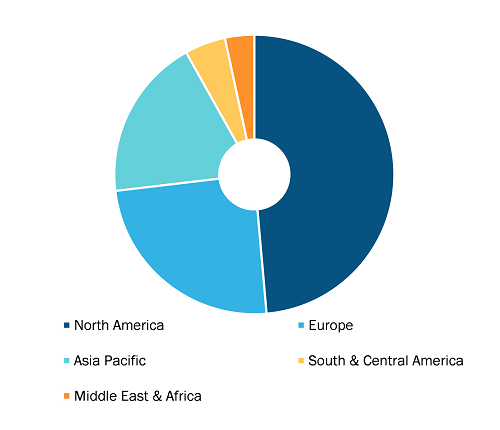The global airway management devices market size is expected to reach US$ 3,100.64 million by 2028, registering a CAGR of 6.9% from 2022 to 2028, according to a new research study conducted by The Insight Partners. The report highlights the key factors driving the market and prominent players with their developments in the market.
Rise in Prevalence of Respiratory Disorders to Drive Airway Management Devices Market During 2022–2028
Based on product, the global airway management devices market is segmented into infraglottic devices, supraglottic devices, laryngoscopes, resuscitators, and others. In 2021, the infraglottic devices segment held the largest share of the market. The growing demand for single-use airway management devices is anticipated to offer significant opportunities to the market during the projected period. Based on end user, the global airway management devices market is segmented into hospitals, ambulatory surgical care centers, and others. The hospitals segment accounted for the largest share of the market in 2021.
Global Airway Management Devices Market, by Region, 2021 (%)
Airway Management Devices Market Size and Forecast (2021 - 2031), Global and Regional Share, Trend, and Growth Opportunity Analysis Report Coverage: By Product [Infraglottic Devices (Endotracheal Tubes, Tracheostomy Tubes, and Others), Supraglottic Devices, Resuscitators, Laryngoscopes, Others] and End User (Hospitals, Ambulatory Surgical Care Centers, and Others) and Geography
Airway Management Devices Market Strategic Insights by 2031
Download Free Sample
The global airway management devices market growth is mainly attributed to the rising prevalence of respiratory disorders. Chronic respiratory diseases are among the most prevalent noncommunicable diseases worldwide due to the increase in the unhealthy environment and occupational and behavioral inhalation. This spectrum of diseases includes chronic obstructive pulmonary disease (COPD), asthma, interstitial lung disease, pulmonary sarcoidosis, and pneumoconiosis (such as silicosis and asbestosis). According to the World Health Organization (WHO), COPD is the third leading cause of death globally. In 2019, ~3.23 million people died globally due to COPD. As per the Office of Disease Prevention and Health Promotion, ~14.8 million adults in the US were diagnosed with COPD in 2020. The National Health Service stated that ~1.17 million people in the UK were diagnosed with COPD in 2021, i.e., ~1.9% of the total population. The Global Asthma Report, 2018, stated that ~300 million people have asthma worldwide, and the estimates indicate that this number will surge by 100 million people by 2025. As per the WHO report, asthma affected 262 million people globally and caused 455,000 deaths in 2019. Moreover, in 2019, asthma resulted in 439,000 hospitalizations and an estimated 1.3 million visits annually in the US. The rising prevalence of respiratory disorders drives the global demand for airway management devices.
The most typical indication of COVID?19 is an acute respiratory infection, with the predominant symptoms of fever, dyspnea, and cough. As the disease progresses, the patients develop increasing breathlessness due to airway obstruction with decreased oxygen saturation. Airway interventions in emergency departments are mainly required to support these breathless patients. The treatment ranges from giving oxygen through a non-rebreather mask, nebulization, non-invasive ventilation (NIV), and even tracheal intubation to optimize and support ventilation. For instance, around 5% of suspected or confirmed COVID-19 patients will develop severe hypoxia or acute respiratory distress syndrome (ARDS), necessitating tracheal intubation in the emergency department. Therefore, the COVID-19 pandemic raised the demand for airway management devices. Airway management devices were crucial in providing care to people critically suffering from the disease, who often struggled to breathe naturally. Although these devices did not cure COVID-19, they could keep a severely ill patient alive until they recover enough lung function to breathe independently. Thus, COVID-19 had a positive impact on the airway management devices market.
Teleflex Incorporated; Smiths Medical; Medtronic; Intersurgical Ltd; Ambu A/S; Medline Industries, Inc.; Koninklijke Philips N.V.; Armstrong Medical; Mercury Medical; and Cook Medical LLC are among the leading companies operating in the airway management devices market.
Companies in the global airway management devices market have adopted various organic and inorganic strategies to expand their presence in the market. Organic strategies mainly include product launches and product approvals. Further, acquisitions, collaborations, and partnerships are among the inorganic growth strategies implemented by them. These growth strategies allow the market players to expand their businesses and enhance their geographic presence. Further, acquisition and partnership strategies help them strengthen their customer base and expand their product portfolios. A few significant developments by key players in the airway management devices market are listed below.
- In July 2022, Mercury Medical received MDR CE Mark Certification for its CPR manual resuscitation line. This ensures the quality system is in accordance with Regulation (EU) 2017/745, allowing CPR product line sales in the European market.
- In December 2020, Eakin Healthcare Group acquired Armstrong Medical. This will expand a new therapeutic area specialized in respiratory care products, further developing innovative medical products in Northern Ireland.
Contact Us
Phone: +1-646-491-9876
Email Id: sales@theinsightpartners.com